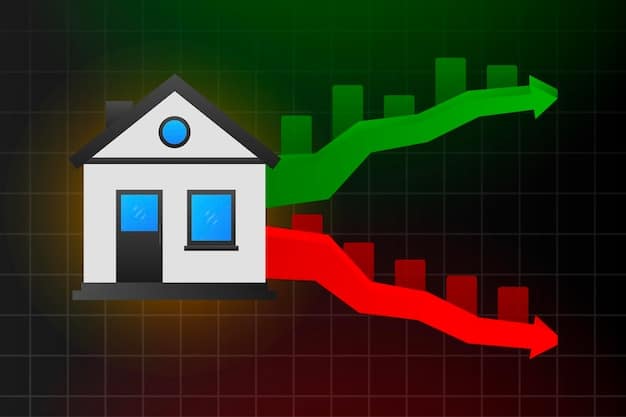Extreme Weather’s Impact on US Energy Infrastructure: Future Trends

The increasing frequency of extreme weather events poses significant threats to the US energy infrastructure, leading to disruptions in energy supply, increased costs for repairs and upgrades, and a greater need for resilient energy systems.
The United States’ energy infrastructure faces unprecedented challenges due to the escalating frequency of extreme weather events. Understanding how will the increasing frequency of extreme weather events impact US energy infrastructure is crucial for ensuring a reliable and sustainable energy future.
Understanding the Vulnerabilities of US Energy Infrastructure
The US energy infrastructure, encompassing power grids, oil and gas pipelines, and renewable energy facilities, is inherently vulnerable to extreme weather. This vulnerability stems from factors like aging infrastructure, geographical exposure, and inadequate resilience measures.
Aging Infrastructure and Deferred Maintenance
Much of the US energy infrastructure is decades old, built to withstand historical weather patterns. Deferred maintenance and underinvestment exacerbate these vulnerabilities.
Geographical Exposure to Extreme Weather
Coastal regions are susceptible to hurricanes and storm surges, while inland areas face droughts, wildfires, and extreme temperatures, each posing unique threats to energy assets.
Lack of Resilience and Redundancy
Insufficient backup systems and redundancy measures in the grid contribute to widespread outages during extreme weather events.

In conclusion, several factors intensify the exposure of the US energy infrastructure to extreme weather. Addressing these vulnerabilities is paramount to upholding the energy supply reliability.
The Direct Impacts of Extreme Weather on Energy Systems
Extreme weather events directly impact energy systems, causing damage, disruptions, and escalating costs. These impacts range from physical destruction of infrastructure to operational challenges that affect energy delivery.
- Physical Damage: Hurricanes, floods, and wildfires can directly damage power plants, transmission lines, and pipelines, leading to immediate outages and costly repairs.
- Operational Disruptions: Extreme temperatures can reduce the efficiency of power plants and strain transmission lines, leading to voltage drops and brownouts.
- Supply Chain Issues: Disrupted transportation routes and damaged facilities can hinder the supply of fuels, affecting electricity generation and heating supplies.
Extreme weather doesn’t only cause physical harm, it also causes operational and logistical hurdles that drastically affect the reliability of energy systems.
Economic Costs and Financial Implications
The economic costs associated with extreme weather-related disruptions to energy infrastructure are substantial and far-reaching. These costs include not only direct damages but also indirect impacts on businesses, households, and the broader economy.
Direct Costs of Damage and Repair
Repairing or replacing damaged energy infrastructure is a major financial burden, with costs potentially reaching billions of dollars.
Indirect Economic Impacts
Power outages and energy shortages can disrupt businesses, leading to lost productivity, revenue, and economic activity.
Increased Insurance Premiums and Investment Risks
The escalating frequency of extreme weather events increases risks for energy companies, leading to higher insurance premiums and reduced investment attractiveness.

Ultimately, the economic burden of extreme weather on energy systems is multifaceted and requires proactive investment in resilience measures.
Strategies for Enhancing Energy Infrastructure Resilience
Enhancing energy infrastructure resilience requires a multi-faceted approach that incorporates infrastructure upgrades, policy and regulatory reforms, and technological innovations. These strategies aim to minimize the impact of extreme weather events on energy systems.
Investing in Infrastructure Upgrades
Modernizing aging infrastructure with weather-resistant materials and designs is crucial. This includes burying power lines, reinforcing transmission towers, and upgrading substations to withstand floods and high winds.
Implementing Policy and Regulatory Reforms
Governments can incentivize resilience investments through tax credits, grants, and updated building codes that require energy infrastructure to meet higher standards.
Leveraging Technological Innovations
Smart grid technologies, microgrids, and advanced forecasting tools can improve situational awareness, optimize energy distribution, and enable faster restoration after outages.
In short, upgrading infrastructure and implementing policy changes are crucial to improving the resilience of energy systems with all different strategies.
The Role of Renewable Energy and Distributed Generation
Renewable energy sources and distributed generation (DG) can play a pivotal role in enhancing the resilience of the US energy system. By diversifying energy sources and decentralizing energy production, they can reduce dependence on centralized, vulnerable infrastructure.
Diversifying Energy Sources
Integrating solar, wind, and other renewable energy sources into the grid reduces reliance on fossil fuels and centralized power plants, mitigating the impacts of fuel supply disruptions.
Decentralizing Energy Production with Distributed Generation
DG technologies, such as rooftop solar panels and microgrids, enable local energy production and consumption, creating more resilient and self-sufficient communities.
Enhancing Grid Flexibility and Reliability
Renewable energy and DG can enhance grid flexibility by providing ancillary services, such as frequency regulation and voltage support, which improve overall system stability.
In summary, renewable energy and distributed generation present opportunities to enhance the resilience of US energy systems by diversifying energy sources and decentralizing energy production.
Policy Recommendations and Future Directions
Addressing the challenges posed by extreme weather to US energy infrastructure requires comprehensive policy measures and forward-thinking approaches. Policy recommendations should promote investments, resilience, and collaboration among stakeholders.
Investing in Weatherization and Resilience Planning
Federal and state governments should provide financial incentives for energy companies to invest in weatherization projects and resilience planning.
Promoting Interagency Coordination and Data Sharing
Enhanced collaboration among government agencies, energy companies, and research institutions is essential for sharing data, best practices, and lessons learned.
Developing Long-Term Strategies for Climate Adaptation
Policymakers should develop long-term strategies for climate adaptation that consider the changing frequency and intensity of extreme weather events.
In conclusion, these recommendations promote investments, resilience, and collaboration among stakeholders.
| Key Point | Brief Description |
|---|---|
| ⚠️ Infrastructure Vulnerabilities | Aging infrastructure and geographical exposure increase risks. |
| 💸 Economic Impacts | Direct damage and business disruptions lead to substantial costs. |
| 🛡️ Resilience Strategies | Upgrades and policy reforms are essential for enhancing resilience. |
| 🌱 Renewable Integration | Diversifying energy sources enhances overall system stability. |
Frequently Asked Questions
Extreme weather events such as hurricanes, ice storms, and heat waves can damage power lines, substations, and other critical infrastructure, leading to widespread power outages.
Energy disruptions can result in significant economic losses due to business closures, spoiled inventory, and increased costs for emergency services and repairs.
Energy infrastructure can be made more resilient by upgrading to weather-resistant materials, burying power lines, and implementing smart grid technologies.
Renewable energy sources like solar and wind can enhance energy resilience by diversifying the energy supply and reducing dependence on centralized power plants.
Supportive policies include investments in weatherization, incentives for renewable energy, and regulations that require energy infrastructure to meet resilience standards.
Conclusion
In conclusion, the increasing frequency of extreme weather events poses a critical threat to the US energy infrastructure. Addressing these challenges requires a proactive approach involving infrastructure upgrades, policy reforms, technological innovations, and the integration of renewable energy sources to ensure a resilient, sustainable, and reliable energy future for the United States.





